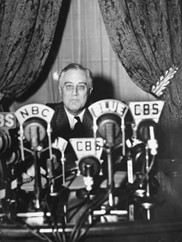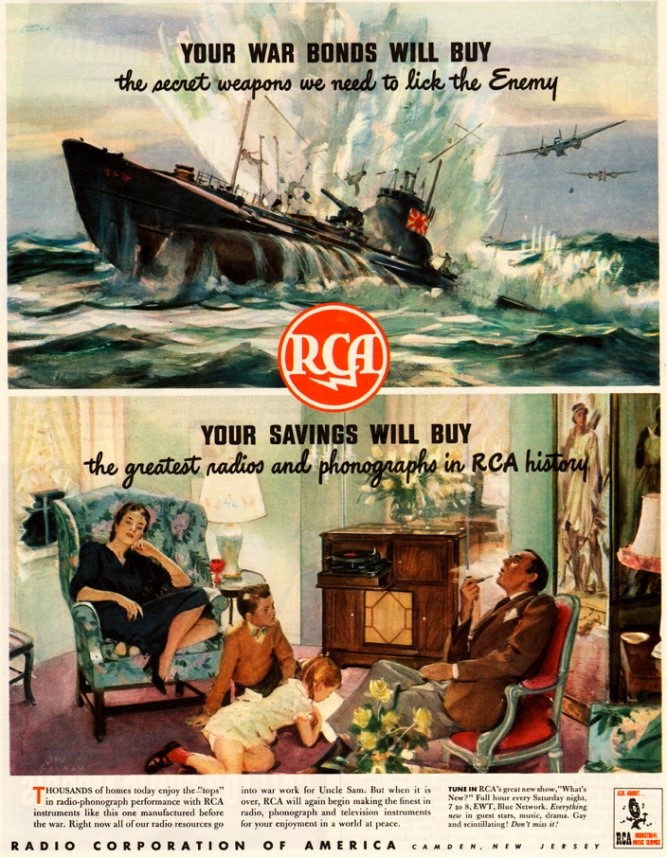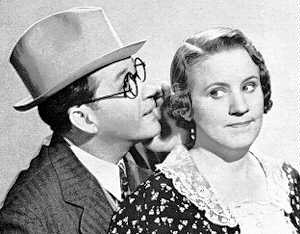It wasn’t until after the sinking of the Titanic in 1912 that radio for mass communication became a viable solution. It became a vital tool during WWI, especially for air and naval operations, and sped the developments of vacuum tube technology and introduced the transceiver. The Golden Age of Radio began in the early 1920s and ran through the 1950s, when television entered the picture. Numerous radio stations were created after the Great War and on August 31, 1920 the first news program was broadcast on station 8MK from Detroit, which was owned by the Detroit News. By 1922 a Variety magazine ad touted “Radio Sweeping Country: 1,000,000 Sets in Use.”

Photo Courtesy of NPR.com
Americans were soon tuning in to hear not only the news of the day but music, comedy, detective dramas, and much more. In early radio, commercials as we know them today, were uncommon and were considered invasive. Although many companies sponsored their own shows, like Betty Crocker’s Cooking School of the Air, the sponsors of radio programs did have naming rights, like the Champion Spark Plug Hour and Fleischmann’s Yeast Hour (which featured Rudy Vallee). Musical features became one of the most popular formats. Leading orchestras and symphonies performed as well as a little show called the National Barn Dance, which was eventually broadcast from Nashville and renamed Grand Ole Opry in 1927.
Vaudeville stars and top comedians also broadcast their talent on radio. Abbott & Costello, Bob Hope, Burns and Allen, as well as situation comedies like Our Miss Brooks were big hits. Other shows, like Dick Tracy, Lil Abner, and Little Orphan Annie were pulled from comic strips to become classic radio programs.
Soon there were quiz shows, soap operas, and sports! The 1938 boxing rematch between American Joe Louis and German Max Schmeling, which took place just months after Adolf Hitler’s army marched into Austria, is believed to have had the largest audience in history for a single radio broadcast. NBC radio announcer Clem McCarthy delivered the blow-by-blow that lasted just two minutes and four second. This fight united an estimated 70 million American radio listeners, across age and color barriers, like no other event before WWII. When the Brown Bomber knocked out Schmeling, he became an American hero.
On September 3, 1939 radio listeners heard Britain and France declare war on Germany and speeches by the UK Prime Minister and US President Roosevelt as it happened. When the US was bombed at Pearl Harbor on December 7, 1941 the first notice of the attack came at 2:26pm, Eastern Time, interrupting a football game, just 63 minutes after the first bombs fell. For the first time in the history of war, people at home heard news in real time. Radio gave listeners an even fuller picture of life on the battle front as war correspondents, like the award-winning journalist Edward R. Murrow, provided boot-on-the-ground radio reporting. Programs like the United Press Syndicated sponsored Soldiers of the Press (1942-1945) broadcasted the adventures of news correspondents on the front line for the first time.
President Roosevelt also used radio to communicate directly to Americans. FDR began his fireside chats in 1933 and continued until 1944. He spoke about the declaration of war, its process, and made Americans feel like they were all in this fight together. The Office of War Information (OWI) worked with broadcasters to fill the airwaves with propaganda. Programs like This is War (1942), were intended to inform Americans about the reasons the US was fighting the War. The OWI called upon the greatest talent in radio to support this project, making it hugely popular. Lest We Forget (1943-1948) was a series with the central theme of combating prejudice and reinforcing American Ideals and Morals.

Photo Courtesy of Museum of Magnetic Sound
Radio soon became the most popular form of media and companies all competed for the best air time slots. Americans were generally supportive of the war, so companies would link their products to patriotism to help boost sales. Advertising companies would sell their product while also giving the listeners information on “how to make food healthier” or “how to make your limited ration stretch farther.” So the public felt that even advertisers, like Shell Oil, were being helpful in time of war. Shell’s radio ad advised: “Your car and tires are a national asset now! See that you keep them in good condition. To help you get longer wear from your tires and car – Shell now offers Ground Crew Service, patterned after rigid Army Air Corp routine. …its absolutely free at all Shell dealers displaying Ground Crew Wings.” Shell offered a free logbook to track your service and tell you exactly what work you needed to have done to lengthen your car’s service and get extra mileage from your tires. “Just as the Army Air Corps mechanics record the work they do on Uncle Sam’s fighting planes.”
Other programs were more subtle but no less effective in their messaging. According to otrcat.com website’s WWII on the Air, Fibber McGee and Molly was one of the OWI department’s favorite programs. At the beginning of the show that was broadcasted December 9, 1941, two days after the attack on Pearl Harbor, the show’s announcer read a message from the President of S.C. Johnson Wax, the show’s sponsor: “The United States is at War, we are all ready and eager to do our part. The makers of Johnson Wax and GloCoat believe it is in the Public’s best interest to continue programs as entertaining as Fibber McGee and Molly. They have a place in the National Morale….We have asked the National Broadcasting Company to feel free at any time to cut into the program with important news flashes and announcements. Signed, H.S. Johnson Jr. “

Photo Courtesy S C Johnson Co.
Fibber McGee and Molly’s theme supported the propaganda, with many episodes that included plots to uncover spies or Fibber addressing complaints about war time rationing. A memorable episode on Photo Photo Courtesy of NPR.com December 1, 1942 had Fibber getting a lesson about rationing from a beloved member of the show’s cast. Mayor LaTrivia played by Gale Gordon, teaches Fibber about the importance of gas rationing as his character and the actor, in real life, leave to join the Coast Guard. (Gordon served four years and then returned to later become a TV actor. Among his most famous roles was that of Mr. Theodore J. Mooney on the Lucy Show for 11 years.)
S.C. Johnson also ended each Fibber McGee and Molly broadcast with an appeal for the Defense Bond Drive “to ensure our Victory, we must turn our dollars into guns and our dimes into bullets.” And the cast would then lead the audience in a chorus of “My Country ‘tis of Thee.”
The radio successfully entertained Americans throughout the dark times of WWII while also providing updates on the war. Advertisers sponsored programs and sold products while still providing a moral boost and instructional messaging. Broadcast companies and governmental departments worked to unite Americans in the fight for victory. Yet with all of radios success and advancements in technology by 1950 five million television sets were sold and by 1960 90% of American homes contained a TV. The Golden Era of Radio was truly over.
Visit www.otrcat.com/world-war-ii-in-the-air for the history of radio for the troops.
